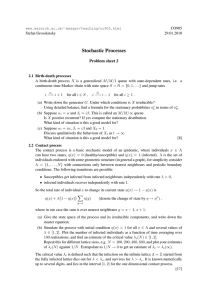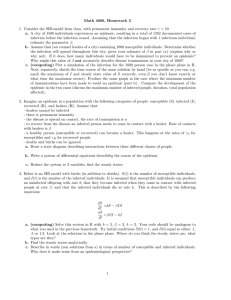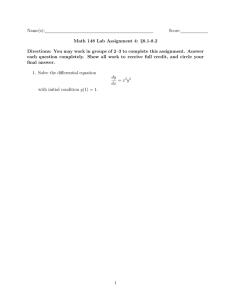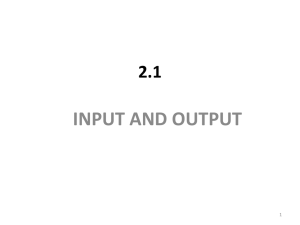A MONTE CARLO METHOD FOR THE SPREAD OF MOBILE MALWARE
advertisement
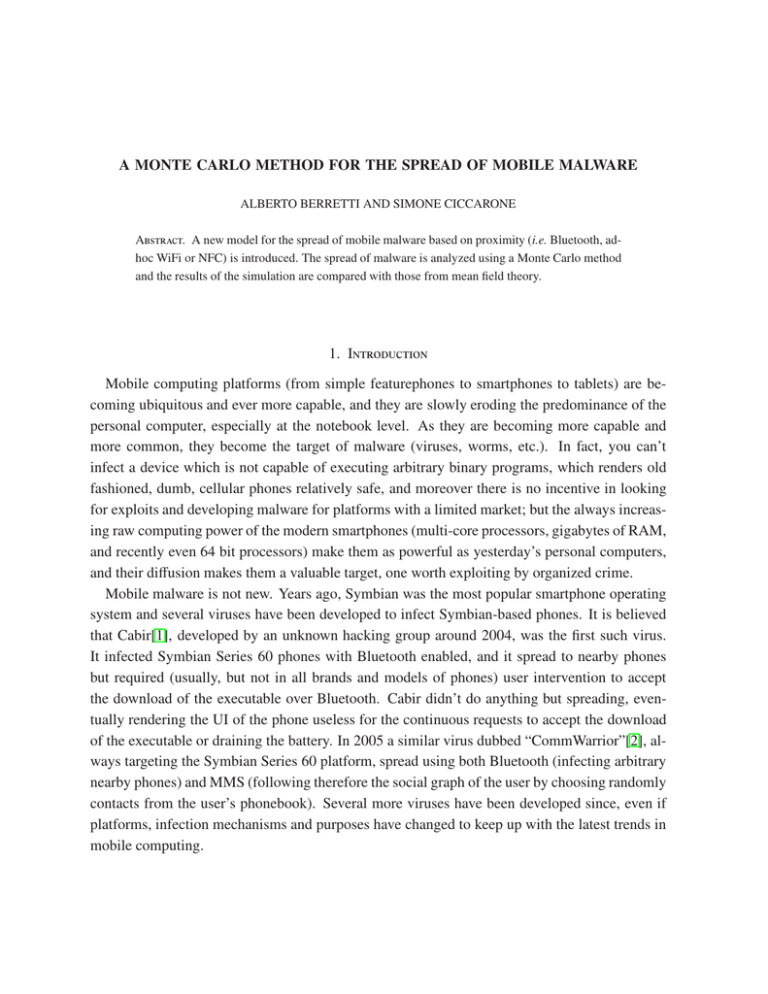
A MONTE CARLO METHOD FOR THE SPREAD OF MOBILE MALWARE
ALBERTO BERRETTI AND SIMONE CICCARONE
Abstract. A new model for the spread of mobile malware based on proximity (i.e. Bluetooth, adhoc WiFi or NFC) is introduced. The spread of malware is analyzed using a Monte Carlo method
and the results of the simulation are compared with those from mean field theory.
1. Introduction
Mobile computing platforms (from simple featurephones to smartphones to tablets) are becoming ubiquitous and ever more capable, and they are slowly eroding the predominance of the
personal computer, especially at the notebook level. As they are becoming more capable and
more common, they become the target of malware (viruses, worms, etc.). In fact, you can’t
infect a device which is not capable of executing arbitrary binary programs, which renders old
fashioned, dumb, cellular phones relatively safe, and moreover there is no incentive in looking
for exploits and developing malware for platforms with a limited market; but the always increasing raw computing power of the modern smartphones (multi-core processors, gigabytes of RAM,
and recently even 64 bit processors) make them as powerful as yesterday’s personal computers,
and their diffusion makes them a valuable target, one worth exploiting by organized crime.
Mobile malware is not new. Years ago, Symbian was the most popular smartphone operating
system and several viruses have been developed to infect Symbian-based phones. It is believed
that Cabir[1], developed by an unknown hacking group around 2004, was the first such virus.
It infected Symbian Series 60 phones with Bluetooth enabled, and it spread to nearby phones
but required (usually, but not in all brands and models of phones) user intervention to accept
the download of the executable over Bluetooth. Cabir didn’t do anything but spreading, eventually rendering the UI of the phone useless for the continuous requests to accept the download
of the executable or draining the battery. In 2005 a similar virus dubbed “CommWarrior”[2], always targeting the Symbian Series 60 platform, spread using both Bluetooth (infecting arbitrary
nearby phones) and MMS (following therefore the social graph of the user by choosing randomly
contacts from the user’s phonebook). Several more viruses have been developed since, even if
platforms, infection mechanisms and purposes have changed to keep up with the latest trends in
mobile computing.
2
ALBERTO BERRETTI AND SIMONE CICCARONE
Malware which explicitly targets mobility can exploit two characteristics: follow the social
graph of the user exploiting access to the user’s phonebook entries (“social malware”, sometime
also called “topological malware” to stress the influence on the topology of the social graph on
its spread), or use protocols based on proximity like Bluetooth, ad-hoc WiFi connections or NFC
(“proximity-based malware”). In this paper we focus on this last aspect of mobile malware,
developing a “microscopic”, stochastic model for the propagation of the infection suitable for
Monte Carlo simulations.
2. Definition of the model
When modeling infections spread via proximity it is natural to consider percolation models,
where susceptible objects occupy sites on a regular lattice – or are distributed with different
topologies: for example a graph – and the infection spreads from an infected site to neighbour
sites. This approach doesn’t take into account mobility, where neighbours change as each susceptible object moves around.
A simple and realistic way to take into account mobility is to make each object perform a
random walk in a regular lattice. As objects get to approach, an infected one can pass on the
infection to each of its – temporary – neighbour, with a given probability.
To be definite, we assume that N susceptible objects perform a random walk on a square
portion of a two-dimensional lattice L = {0, . . . , L − 1} × {0, . . . , L − 1}. The density of objects
is therefore d = N/L2 . These objects are initially placed in some arbitrary way on the lattice, for
example are uniformly distributed. Time is discrete, and each object performs a random walk
moving with equal probability in one of the four possible directions into one of the four nearest
neighbour sites.
We have to deal somehow with the finite size of the box L in which the objects move. “Free”
boundary conditions, in which each object is free to leave the box L, would deplete the box itself
with probability one after a finite amount of time, so one would have to take into account the
appearance of new objects which move into L: this would give rise to a model with variable
number of objects, something like a “grand canonical ensemble” in statistical mechanics. We
prefer for the moment to avoid the complexity of dealing with disappearing and reappearing new
objects, which we consider inessential to the problem, so we use periodic boundary conditions: as
one object moves out of L on one side, it reappears from the opposite side of the box; the random
walk happens therefore on a torus. Another possibility would be to have objects bouncing when
they reach the boundary: while this is relatively simple to take into account in the simulation,
again it would add complexity to the model without really changing in any significant way the
phenomenology of the model (as we tested).
SPREAD OF MOBILE VIRUSES
3
Each object can be in one of two states: healthy or infected. As objects move into the same
site the infection can spread from one of the infected object to each one of the object which
occupy the same site with a given probability p. Of course, more than two objects can be on the
same site at a given time: in this case we consider separately all pairs as a possible source of
infection (i.e. if we have three objects on a site, two infected and one healthy, then we test for a
possible infection of the healthy object twice independently, because of the two possible sources
of infection).
As all objects eventually intersect their trajectories, and eventually get the infection, all objects
sooner or later would become infected. We therefore have to take into account also the chance
that a given object heals itself (perhaps because the infection has been detected and dealt with).
So at each (discrete) instant of time each infected object has a probability q of healing.
We therefore have three parameters which determine the spread of the infection on a given
box L (besides the size of the box): the density of objects d, the probability of infection p and
the probability of healing q. We look at the case in which the box is large, i.e. what would be
called an “infinite volume limit” or “thermodinamical limit” in statistical mechanics. This is
basically a SIS model, using standard epidemiological terminology: recovered objects can get
infected again and don’t get to be immune, as in so-called SIR models. If, using our mobility
model, we were to use a SIR model, all objects eventually would be infected, recover and never
get infected again and the epidemics would stop with probability one in a finite amount of time,
independently on the side of the box.
This model is, mathematically, a Markov chain whit a huge state: if we have M objects in
our box, the different possible configurations are 2 M . It is clearly possible to transition from any
state to any state, with the exception of the state in which all objects are healthy and so there
isn’t anymore a way to get infected: this is an absorbing state that eventually the Markov chain
will reach; for instance, if we have N infected objects, with probability qN (extremely small but
non-zero) they could get all healthy at the same time. We believe that the probability of reaching
such a state in a given fixed amount of time, given some fixed values of p, q > 0 and d, is
exponentially small in the volume of the box and so negligible in the “thermodinamical limit”
that we are considering.
The choice of a square lattice and a simple random walk over it as a mobility model is somewhat arbitrary and motivated basically by mathematical simplicity. More complicated mobility
models could be (and have been) devised. But as we are interested in qualitative features, and
not in exact quantitative features of specific, realistic models, we concentrate our attention on
a mathematically simple model which, while avoiding the complexities of a realistic one, keeps
its qualitative features, much in the spirit of most statistical mechanical models commonly used
4
ALBERTO BERRETTI AND SIMONE CICCARONE
in mathematical physics. As a byproduct, our simulation code is simpler, faster and more efficient. We also emphasize that our model, being based on a discrete random walk in a lattice, is a
discrete time simulation.
3. Related work
A few papers have studied simulations of SIS models via random walks. In [3] the spatial distribution of nodes in a random waypoint model is studied, and it is shown to be inhomogeneous.
The authors only take into account the distribution of the agents, without ever considering propagation of infection. They use physical units of measures in the simulation, taking into account
an area of 1000 × 1000 square meters divided into square cells whose side is 20 meters, so they
actually use 50 × 50 lattice (and so quite small).
In [4] the transmission of messages in a network of mobile nodes is studied. The authors again
use physical units and so they consider an area of 1500 × 300 meters where 50 agents move using
a random waypoint model, with a transmission radius which varies between 10 and 2500 meters
(so again the effective size of the region is quite small). Using a simulation the authors study the
mean time to deliver a message and the number of hops necessary to reach destination.
In [6] a SIR model with different mobility models is considered, with a populations of up to
1000 objects and a time of up to 1000 discrete units, and they look at the average number of
immunized objects.
In [7] are used again physical units: they consider an area of dimension 200 × 200 m with an
interaction radius of 5 m, so the model can be compared to a lattice model with dimension 40×40,
that is rather small. Several mobility models are taken into account, suitable for a continuous
space and time model. The author computes an approximate formula for the infection threshold
and shows that it depends only by the ratio of the probabilities of infection and disinfection.
While similar in general conception, our model is rather different (and quite simpler to simulate:
in fact we could handle a simulation with a much larger number of agents and area) as it is
based on random walks on a lattice, and we found instead a more complex dependence of the
epidemic threshold from infection and disinfection probabilities, even in the mean field theory
approximation.
4. The simulation
The code for the simulation has been written in C to achieve optimum performance. We ran in
on a small cluster using at most eight computational cores (four Intel Xeon dual core processors
at 3 GHz) and on a small personal workstation (with an Intel I3 processor at 3.1 GHz), all running
Linux.
SPREAD OF MOBILE VIRUSES
5
We used square lattices of sizes from 16x16 up to 512x512. The results from lattices of
different size have been compared and we observed that they do not change significantly for
lattices of size higher than 64 x 64, while they are more volatile for lattices of smaller sizes: so a
kind of “thermodinamical limit” is practically achieved already for this size. So we settled for a
size of 128x128.
The population density was chosen between 0.1 and 1 in step of 0.1, and also a few run at
higher densities have been performed (with densities equal to 2, 5 and 10). Note that densities
higher than 1 imply that most sites are occupied by more than one agent, which is entirely
possible within our model.
The built-in random number generator of the compiler has been used for the simulations.
As expected, the limit fraction of infected agents f∞ doesn’t depend on its initial value f0 , so
we took f0 = 0.2 in all production runs. We also took a uniform initial distribution of the agents,
as we expect that at equilibrium the agents are uniformly distributed (but we can’t say anything
about eventual fluctuations).
We performed an autocorrelation analysis of the data from each simulation, to compute its
autocorrelation time τ. This is of course what must be done in any dynamic Monte Carlo simulation to insure that data points are taken from an equilibrium distribution and that they are taken
sufficiently far apart so that they can be considered independent. In our case, moreover, the time
to reach the equilibrium is an interesting quantity per se. To compute autocorrelation times, we
used a Python version of the acor package written by Jonathan Goodman [8].
5. Mean Field Theory
We can approximate our model using a kind of “mean field theory” approach, which is expected to have a qualitatively agreement with the complete, exact model. In this approximation
we consider a single object, whose evolution is based on the average behaviour of the rest of the
system.
In average, each objects undergoes ≈ d intersections at each time, with each intersection
giving a chance to get infected if it happens with an infected object. As f = N/M is the fraction
of the infected objects, at each time each object approximately intersects with an infected one
“ f d times”.
Therefore approximately the probability that an object gets infected is p′ = 1 − (1 − p) f d –
pretending that f d is an integer –, that is 1 minus the probability of never getting infected in each
of its f d intersections with an infected object.
So considering each object individually, let X = H or I denote the status of an object (H for
healthy and I for infected). The following diagram explains the transition to the new state with
each probability:
6
ALBERTO BERRETTI AND SIMONE CICCARONE
H
qq88
q qqqq
qq
qqq
q
q
q
AA I MMMM
MMM1−q
MMM
MMM
′
M&&
p I
p′ q
p′ (1 − q)
X;
;;
;;
;;
;; 1−p′
;;
;;
;;
;;
;
H
qq88
q qqq
qq
qqq
q
q
q
X MM
MMM
MM1−q
MMM
MMM
&&
X
(1 − p′ )q
(1 − p′ )(1 − q)
The dynamics of a single object can therefore be approximated by a much simpler Markov
chain, where the state space is just the set {H, I} (being healthy or being infected) and the transition probabilities are given by:
State at t State at t + 1
H
H
I
I
Probability
p′ q + (1 − p′ )q + (1 − p′ )(1 − q) = 1 − p′ + p′ q
p′ (1 − q) = p′ − p′ q
p′ q + (1 − p′ )q = q
p′ (1 − q) + (1 − p′ )(1 − q) = 1 − q
H
I
H
I
The transition matrix is therefore:
1 − p′ + p′ q p′ − p′ q
.
M =
q
1−q
This is an ergodic Markov chain whose invariant probability distribution is given by the normalized eigenvector of the eigenvalue 1, given by:
q
p′ + q − p′ q
p′ − p′ q .
p′ + q − p′ q
SPREAD OF MOBILE VIRUSES
7
This Markov chain therefore approach an equilibrium state with a probability of having an inp′ − p′ q
. We take this value as the mean-field approximation for the
fected object equal to ′
p + q − p′ q
fraction of the infected objects:
p′ − p′ q
.
fMF = ′
p + q − p′ q
As p′ depends on the fraction of the infected objects itself, after a few elementary steps we obtain
a transcendental equation for fMF :
q
fMF = 1 −
.
(5.1)
1 − (1 − q)(1 − p) fMF d
Please note that besides assuming a perfect uniform distribution of agents and also a perfect
uniform distribution of infected agents, we also assumed f d to be an integer, which of course
is another approximation. Moreover in mean field theory there is always a chance of getting
infected (the Markov chain is actually really ergodic).
To compute the epidemic threshold in mean field theory, we start by observing that equation
(5.1) always has a solution f = 0. So we are in the epidemic regime it there is another solution
f = fMF > 0, for given values of p, q and d. To study the existence of solutions to (5.1) we
consider the intersection of the graph of:
q
φ( f ) = 1 −
1 − (1 − q)(1 − p) f d
with the bisectrix of the first quadrant with 0 ≤ f ≤ 1. By trivial calculations, we have that for
any physical values of p, q and d (0 ≤ p ≤ 1, 0 ≤ q ≤ 1, d ≥ 0) φ′ ( f ) > 0 and φ′′ ( f ) < 0 and
of course φ(0) = 0, φ( f ) < 1. Therefore if φ′ (0) > 1 we have another solution f = fMF ∈ (0, 1),
while if φ′ (0) ≤ 1 the only solution to (5.1) is f = 0. So the condition φ′ (0) = 1 determines the
epidemic threshold in mean field; a trivial calculation gives:
q0 =
1
d log 1−p
1
1 + d log 1−p
,
with the epidemic thriving if q < q0 and extinguishing if q > q0 .
Contrary to the findings of other authors, the data obtained by the simulation doesn’t seem to
show a dependence of the number of infected agents at equilibrium, or of the epidemic threshold,
exclusively by the mere ratio p/q, as happens in different, typically continuous-time, models.
The epidemic threshold q0 (p, d) is only approximately linear for small values of p and d, which
is what we expect to matter, heuristically, if we were to take a sort of continuum time limit of our
model. In fig. 1 we plotted the epidemic threshold q0 (p, q) for selected values of d.
8
ALBERTO BERRETTI AND SIMONE CICCARONE
6. Results of the simulation and future work
The observed fraction of infected agents at equilibrium f∞ depends on all the three parameters:
the infection probability p, the disinfection probability q and the density of agents d. There
appear to be a value q∗ (p, d) such that if q > q∗ then f∞ = 0 while if q < q∗ then f∞ , 0, as the
mean field theory predicts. q∗ is increasing both in p and in d, as it can be easily expected. q∗ is
again, as predicted by mean field theory, not linear in p, and so there’s no “epidemic threshold”
depending simply on the ratio p/q. In fig. 2 we see some plots of q∗ (p, d) for selected values of
d.
The empirical results are qualitatively similar to the predictions of mean field theory, but there
are some quantitative discrepancies which are stronger for small densities of infected agents. We
believe that the discrepancies are mostly due to the fact that, ultimately, the mean field model
is an ergodic Markov chain while the real model, which we simulate, is not actually ergodic as
there is a state (no infected agents at all) which is attracting. Simply said, in mean field theory,
where we consider only one agent, it can always get infected, while in the real model when there
are no longer any infected agents the infections has no chance to reignite itself. Also, when in the
real model the density of infected agents is small enough the chance to interact with one of the
few remaining infected agents is practically negligible and unless q is extraordinarily small the
infections dies out fast. Note also that in our model the probabilities of infection and disinfection
p and q are actual probabilities of events happening upon intersection of the trajectories of the
agents, not the infection and disinfection frequencies (which are observable random variables
and not parameters of the model).
Concluding, we proposed a model for the propagation of a malware epidemic between mobile
agents moving randomly on a plane, regular lattice. From the purely mathematical point of
view changing the dimension of the lattice would probably mean a lot, since it would impact
the probability of intersection of the random walks, but we fail to see a practical application for
higher dimensional lattices. It would be very interesting anyway to change the topology of the
environment in which the agent move: for example, the agents could be constrained by having
malware spreading along a graph of connections which is more general than a simple square
lattice. This would rise the interesting problem of finding an optimal containment strategy for the
epidemic (or even just a better one) by modulating the probabilities of infection and disinfection
depending on the topological properties of the graph.
Acknowledgments. We thank the Department of Mathematics of the University of Tor Vergata
for kindly providing all the computing resources needed for this work.
SPREAD OF MOBILE VIRUSES
9
References
[1] F-Secure, Bluetooth-Worm:SymbOS/Cabir, http://www.f-secure.com/v-descs/cabir.shtml, retrieved
Oct. 26th, 2013.
[2] Symantec, SymbOS.Commwarrior.I, http://www.symantec.com/security_response/writeup.jsp?
docid=2006-052510-4833-99, retrieved Oct. 26, 2013.
[3] The Spatial Node Distribution of the Random Waypoint Mobility Model; Bettstetter, Christian; Wagner, Christian; Mobile Ad-Hoc Netzwerke, 1. deutscher Workshop über Mobile Ad-Hoc Netzwerke WMAN 2002
[4] Epidemic Routing for Partially Connected Ad Hoc Networks; Vahdat, Amin; Becker, David; Duke University;
2000
[5] Modeling epidemic spreading in mobile environments; Mickens, James W.; Noble, Brian D.; WiSe ’05 Proceedings of the 4th ACM workshop on Wireless security; 2005
[6] Agent-Based and Population-Based Simulation: A Comparative Case Study for Epidemics; Jaffry, S. Waqar;
Treur, Jan; Proceedings of the 22th European Conference on Modelling and Simulation, ECMS’08. European
Council on Modeling and Simulation; 2008
[7] Epidemic spread in mobile Ad Hoc networks: determining the tipping point; Valler, Nicholas C.; Prakash, B.
Aditya; Tong, Hanghang; Faloutsos, Michalis; Faloutsos, Christos; NETWORKING’11 Proceedings of the
10th international IFIP TC 6 conference on Networking - Volume Part I; 2011
[8] http://www.math.nyu.edu/faculty/goodman/software/software.html
Dipartimento di Ingegneria Civile ed Ingegneria Informatica, Università di Tor Vergata, Roma, Italy
E-mail address: berretti@disp.uniroma2.it
Dipartimento di Ingegneria Civile ed Ingegneria Informatica, Università di Tor Vergata, Roma, Italy
E-mail address: simone.ciccarone@uniroma2.it
10
ALBERTO BERRETTI AND SIMONE CICCARONE
(a) d = 0.3.
(b) d = 0.5.
(c) d = 0.7.
(d) d = 0.9.
(e) d = 1.
(f) d = 2.
(g) d = 5.
(h) d = 10.
Figure 1. Epidemic threshold given by mean field theory q0 (p, q) for selected values of d.
SPREAD OF MOBILE VIRUSES
11
(a) d = 0.3.
(b) d = 0.5.
(c) d = 0.7.
(d) d = 0.9.
(e) d = 1.
(f) d = 2.
(g) d = 5.
(h) d = 10.
Figure 2. Empirical epidemic threshold q∗ (p, q) for selected values of d.


